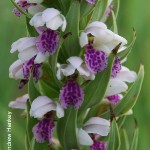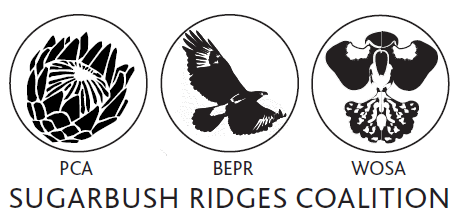Brachychorythis conica subsp. transvaalensis - Conservation Plan
A Project proposal by Wild Orchids Southern Africa
(WOSA Collaboration with the Walter Sisulu National Botanical Garden (WSNBG).
Introduction:
WOSA is a sub‐committee of the Witwatersrand Orchid Society concerned with the conservation of
South Africa’s naturally occurring diversity of orchid species. Walter Sisulu National Botanical Garden (WSNBG) is a national conservation garden under the South African National Biodiversity Institute. These two organs have come together in collaboration to promote the sustainability and conservation of the species in question and the habitat that supports it.
This specific document does not contain detailed location data of the species.
Interest in the conservation of Brachycorythis conica subsp. transvaalensis originated in
2007 when the species was re‐discovered on municipal and private land adjacent to the WSNBG nature reserve (Hankey, 2013). The species was first recorded on this site in 1956 by J.P.H. Acocks during his extensive field work which covered vast areas of South Africa. Subsequently the species went largely unnoticed for many years, the rediscovery of the species at the same site in 2007 sparked alarms for conservationists as the species was slipping close to extinction with little known about its population biology. In 2010 a collaborative field excursion was conducted by several departments of SANBI (WSNBG; MSB; TSP) as well as GDARD to study historical localities, to assess whether the species was still extant at any of the historical Gauteng based localities. As a result of that field work it was concluded that the Krugersdorp population remained as the only known viable population in existence (von Staden et.al. 2010). All of the historical sites visited where the species was recorded had subsequently been developed or altered during the rapid expansion of Johannesburg and Pretoria which had resulted in the local extirpation of the species.
The project proposal which follows is developed in an effort to address the pending threats to the species and introduce efforts to save the species from extinction
Backround:
The species was first recorded on this site in 1956 by J.P.H. Acocks during his extensive field work which covered vast areas of South Africa. Subsequently the species went largely unnoticed for many years, the rediscovery of the species at the same site in 2007 sparked alarms for conservationists as the species was slipping close to extinction with little known about its population biology. In 2010 a collaborative field excursion was conducted by several departments of SANBI (WSNBG; MSB; TSP) as well as GDARD to study historical localities, to assess whether the species was still extant at any of the historical Gauteng based localities. As a result of that field work it was concluded that the Krugersdorp population remained as the only known viable population in existence(von Staden et.al. 2010). All of the historical sites visited where the species was recorded had subsequently been developed or altered during the rapid expansion of Johannesburg and Pretoria which had resulted in the local extirpation of the species.
The Species:
Brachycorythis conica ssp. transvaalensis must be the most magnificent and yet also most threatened of the Brachycorythis subspecies. The other two subspecies Brachycorythis conica ssp. conica and Brachycorythis conica ssp. longilabris are found in Tropical Africa.
The subspecies Brachycorythis conica ssp. transvaalensis is endemic to the Highveld with a distribution mainly in Gauteng. The species is listed as Endangered (EN A2c) in the Red List of South African Plants (Annexure 1). Plants have been recorded near Middelburg and Roosenekal in Mpumalanga and few in Limpopo, although most of these records are of solitary or very few individuals. This orchid is also one of the larger of its kind which makes a first view of it quite regal. Even the flowers themselves are quite grand in size. This species flowers from January to April. J.K. Welwitch recently noted the possible pollinator of the orchid, which was a medium sized, greyish coloured bee approaching the flowers (J.K. Welwitch pers. comm.). Other orchids growing in the nearby vicinity are Disa patula var. transvaalensis, Habenaria nyikana, H. caffra, H. epipactidea, H. dregeana, H. schimperiana, Holothrix randii, Eulophia clitellifera, E. clavicornis, E. ovalis subsp. bainesii, Bonatea antennifera, Disperis micrantha.
Read the full article here Conservation plan Brachycorythis conica ssp transvaalensis.pdf


